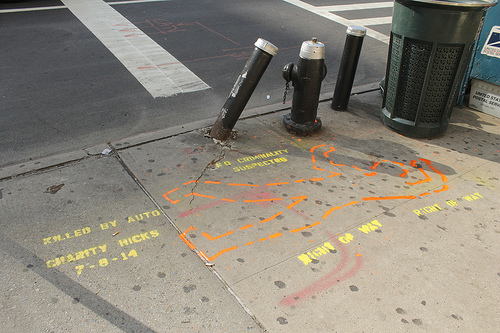A dozen locations in New York City now sport them: Ornate, white stencils of outstretched wings. Below each is the name of the pedestrian killed at that site and the date of the fatality.

New York’s Right of Way is notable for their unusually direct and confrontational approach to pedestrian and bike safety. Image by Liz Patek.
Designed by artist Robyn Renee Hasty, the stencils are the work of pedestrian advocacy group Right of Way, best known for the chalk body outlines it drew at New York City intersections in the early 90s to raise awareness of pedestrian fatalities at those locations.
The group revived its efforts last month with the stencils, which organizer Keegan Stephan hoped would get the NYPD and the public “to think there was a crime committed here, and then to think about how that’s not normally considered a crime—or a tragedy even,” he said.
Although traffic fatalities have decreased dramatically since Right of Way’s first chalk outline, a sobering number of pedestrian deaths still occur in New York City. According to a 2010 report from the city’s Department of Transportation (DOT), pedestrians composed 52% of traffic deaths between 2005 and 2009, four times the average nationwide.
DOT has since begun redesigning streets that more thoughtfully accommodate pedestrians and cyclists, and earlier this year Mayor Bill de Blasio introduced Vision Zero, a legislative package that seeks to eliminate traffic fatalities by 2024, so there are improvements afoot.
But Right of Way observes that there are still significant hurdles when it comes to enforcing new or existing legislation. We still have a culture of victim-blaming and impunity for drivers, said Stephan.
The deaths of Alex Shear and Cooper Stock are grim examples. On January 10, 73-year-old Shear was struck by a tour bus at 96th and Broadway and killed. That same day Stock, age nine, died when a cab turned left onto the crosswalk where he and his father were standing beneath the walk signal.
No charges have been filed against the bus driver who struck Shear, while the taxi driver who killed Stock was issued a traffic citation for “failure to yield to a pedestrian.” If it’s his first offense, he’ll be charged a small fine.
Examples like the above inform the 20% arrest rate for fatal crashes held by the NYPD’s Collision Investigation Squad (formerly Accident Investigation Squad), offering a stark comparison to the homicide unit’s 70% clearance rate.
Unfortunately, New York isn’t the only city with poor pedestrian and cycling safety issues. Indeed, according to an analysis published in Governing magazine last month, pedestrian fatalities occur more often in America’s poorest Census tracts. Actions like those taken by Right of Way serve to remind the public, policymakers, and law enforcement that street design and regulatory protections for pedestrians and cyclists still have much room for improvement.